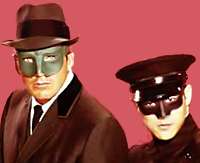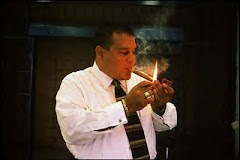
THE GREEN HORNET
Did you ever get a musical theme stuck in your head, and can’t figure out why?
The other day I found myself walking around humming the theme song from THE GREEN HORNET.
Now I have no idea why; it’s not like this was one of my favorite shows, but the tune is one of those catchy television themes you just can’t get out of your head.
A little research revealed the following.
The Green Hornet was originally a radio series that ran between January 31, 1936 to December 5, 1952.
It was created by George W. Trendle and Fran Striker, who also created The Lone Ranger.
It used “Flight of the Bumblebee" as its theme song.
The series detailed the adventures of Britt Reid, debonair newspaper publisher by day, crime-fighting masked hero at night, along with his trusty sidekick, Kato, a Filipino of Japanese ancestry.
With the outbreak of World War II his Japanese heritage was almost completely dropped, leading to the common misperception that the character's nationality had been switched by the show's writers. (When the characters were used in a pair of movie serials Kato's nationality was inexplicably given as Korean.)
The leading character Britt Reid is explained to be a close relative of The Lone Ranger.
In the original introduction of the radio show announcer Mike Wallace proclaimed that the Green Hornet went after criminals that "even the G-Men (FBI agents) couldn't reach".
The show's producers were called by FBI chief J. Edgar Hoover who prompted them to remove the line implying that some crime fighting was beyond the abilities of the FBI.
Inspired by the success of the Batman series, ABC brought The Green Hornet to television in 1966-67, an adaptation which introduced martial arts master Bruce Lee to American audiences and starred Van Williams as the Green Hornet.
Unlike Batman, the TV version of Green Hornet was played straight, but in spite of the considerable interest in Lee, it was cancelled after only one season. However, Bruce Lee’s career skyrocketed from this point. Lee's popularity in Hong Kong, where he was raised, was such that the show was marketed there as The Kato Show.
While the music of "Flight of the Bumblebee" was strongly identified with The Green Hornet, the theme used for the television series was written by Billy May and was played on trumpet by Al Hirt.
Years later, this music was featured during a key scene in the 2003 film, Kill Bill, which paid tribute to Kato by featuring dozens of swordfighters wearing Kato masks during the film's key fight sequence. (Check the link at the end of this site to hear the theme song for yourself, and tell me if you don’t find yourself humming this for hours!).
The TV series featured the Hornet's car, Black Beauty, which was a 1965 Chrysler Imperial. The car's regular headlight cluster could be flipped over to reveal green headlights. It could fire tiny explosive charges from tubes at its bumpers, which were said to be rockets.
The TV series also employed an audio device from the radio show. In its era, the engines of cheaper cars made a lot of noise; the expensive Pierce-Arrow was reputed to be extremely quiet. So, when the Green Hornet said, "rig for silent running," the hornet-like buzz on the radio show was turned off and the listener was left to imagine that the car really was silent. On TV, the car sounded like a modern car, but the noise was removed from the soundtrack after this command.
Green Hornet Theme Song: http://www.mythemes.tv/series/greenhor.htm
IN LOVING MEMORY
I’m sorry to have learned that RET. DET FIRST GRADE JOHN T. REILLY passed away this past week.
John passed away a week ago Monday (October 16) in South Carolina of congestive heart failure at the age of 77 years.
Readers of this site will recall my often-made reference to John as the eminent department historian.
John worked most of his career in Manhattan Detectives and without a doubt was the greatest living NYPD police historian ever.
He was described by Mike Bosak, another wealth of department history, as “intelligent and wise; he was a consummate perfectionist and displayed unlimited perseverance in the search for forgotten truths”.
John was very instrumental in the work that resulted in the addition of 100 MOS who died in the line of duty over the years who, for some reason or another, had been omitted from the department’s memorial wall at 1PP. He also authored a great text on the department’s medal’s and honor recipients.
John would answer any inquiry I had promptly with accuracy and background to prove a point. I don’t know how he did it, but he will be sorely by missed by all who had the pleasure, in one way or another, to know this fine man.
Truly a kind and gentle, loving person. He will be missed. Our thoughts and prayers go out to John’s family.
RECENT CRIME TRENDS
A recent story in the John Jay College of Criminal Justice “Crime and Justice News” notes a recent nationwide crime trend.
In Many Big Cities, Crime Rises While Police Forces Shrink.
The article goes on to note the following:
“Violent crime increases in many big cities are "reasons for concern but not alarm," says criminologist James Alan Fox of Northeastern University.
Still, Fox believes that the crime picture may be worse than was indicated by a recent Justice Department victimization survey because robberies have increased markedly; the total has remained down in large part because of a decline in reported simple assaults, which Fox says often amount to "people shoving each other."
Fox spoke at a panel sponsored by Criminal Justice Journalists at the International Association of Chiefs of Police convention in Boston. A decline in police staffing has hit many of the same cities where crime is rising, he noted. Cities with populations more than 250,000 have suffered cuts totaling more than 9 percent since 2000, Fox said. By contrast, smaller police department numbers have remained steady.
At the same discussion, Police Chief Dean Esserman of Providence, R.I., lamented that many Americans "seem to accept" the fact that "we lose 16,000 people every year" to homicide, five times as many as were killed in the Sept. 11, 2001, terror attacks. "We are burying our children and becoming used to it," Esserman said. He called for a re- emphasis on "hometown defense" as well as homeland security”.
STOP BY JIMMY’S BAGELS
If you find yourself on Route 109 in the area of West Babylon, near Suffolk County Police Department’s First Precinct stationhouse, stop by Jimmy Leake’s Bagel Shop and say hello. (It’s not called “Jimmy’s”, but you can’t miss it – it’s a block away from the stationhouse).
The shop is located just to the north of the police station, also on the east side of the street.
Jimmy retired from the 77 Precinct a few years back on a medical disability, having survived a motorcycle accident, and spent his last year performing clerical work in the 77 Squad. Consistently tortured by “Loud” Mark Pouria while he was working, some things never change as Mark makes it a point to stop by often to make sure Jimmy’s doing his job properly!
Stop by, say hello, ask for Jimmy – and tell him The Minister of Investigation sent you in. It should be good for a cup of coffee, at least!
INTERESTING WEB SITES
Current Military Service:
To determine if an individual is currently serving in any of the military services, you can use this public information website: HYPERLINK
https://www.dmdc.osd.mil/scra/owa/home
You'll need his/her SSN and last name or last name, first name and DOB. It won't tell you where they're serving, only if they're serving and in what branch.
Cell Phone Carrier:
Det Phil Schurr of the Major Case Squad wanted to pass on this web site which you may find valuable.
Neustar will tell you if a cell number has been "Ported".
You can register for this free service as law enforcement at
www.nationalpooling.com
and go to the law enforcement section. They will assign you a pin number to use.
It appears that Neustar is contracted by the FCC to provide this service.
For example, if you switch your Nextel to Verizon and keep your number, this service will let you know it has been “ported”.
SCHOOL BANS PLAYING TAG
http://www.cnn.com/2006/US/10/18/no.tag.ap/index.html
I heard this one morning as I awoke, as a news story on TV, and wasn’t sure I heard it correctly.
Another example of a litigious society over-reaction?
“LEST WE FORGET…” THE NYPD MEMORIAL
October 19, 1929 Ptl Charles Saver, 76 Pct, Shot-robbery in progress
October 20, 1967 Ptl James Dandridge, 32 Pct, Shot:Accidental by MOS
October 22, 1907 Ptl Eugene Sheehan, 3 Pct, Shot by prisoner
October 22, 1931 Det Guido Pessagano, 20 Sqd, Shot-arrest
October 22, 1970 Ptl Gerald Murphy, 9 Pct, Shot-Arrest, off duty
October 22, 1972 Ptl Joseph Meaders, 63 Pct, Crushed by oil truck
October 24, 1935 Capt Richard McHale, 109 Pct, Shot by disgruntled MOS
October 24, 1939 Ptl Anthony Buckner, 32 Pct, Auto accident on patrol
October 24, 2002 Det Salvatore Cafiso, SI Narco, Heart attack, LOD
October 26, 1897 Ptl Frederick Smith, 14 Pct, Shot-burglary in progress
October 26, 1910 Ptl James Mangen, 144 Pct, Head injury, rescue
October 28, 1888 Ptl James Brennan, 21 Pct, Assaulted during arrest
October 28, 1945 Ptl James Bussey, 18 Pct, Shot-investigation
October 29, 1962 Det John Tobin, BCI, LOD Heart attack
October 29, 1982 PO James Whittington, PBBN FIAU, Shot-off duty




